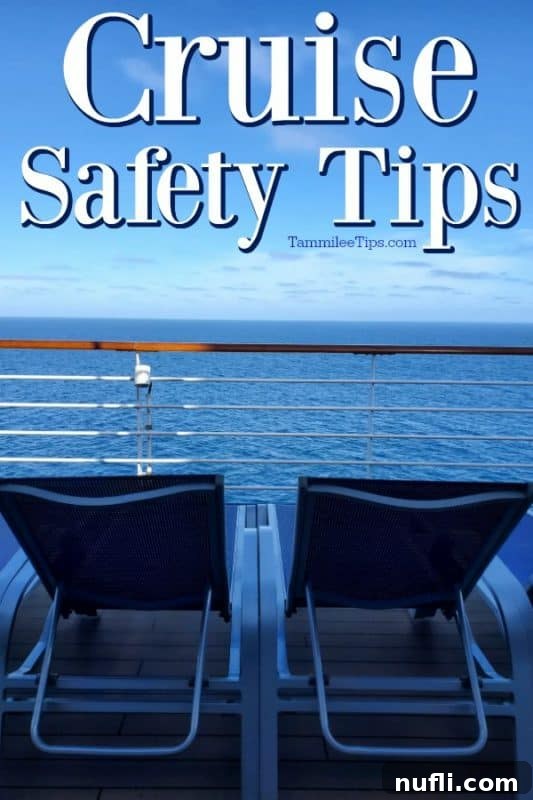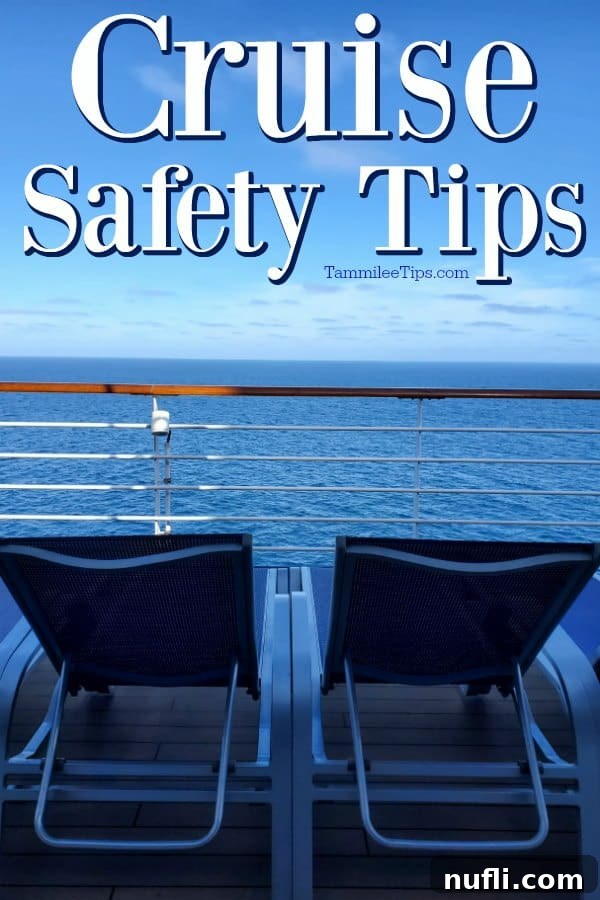Embarking on a cruise vacation promises an unforgettable journey filled with relaxation, adventure, and discovery. As you prepare to set sail and embrace the excitement of “Bon Voyage,” it’s essential to arm yourself with practical knowledge to ensure your trip is not only enjoyable but also safe and secure. While cruises are renowned for their incredible amenities and destinations, being proactive about safety can significantly enhance your experience, allowing you to truly unwind and savor every moment at sea and in port. This comprehensive guide provides essential cruise travel safety tips, designed to help you navigate your voyage with confidence and peace of mind.

Short on time? Here are our top recommendations for your cruise adventure:
🏨Find the Perfect Hotels and Vacation Rentals
📍Discover Exciting Tours and Activities
Comprehensive Cruise Travel Safety Tips for a Worry-Free Vacation
Cruise vacations are the epitome of fun under the sun, offering a unique blend of relaxation and adventure. Having enjoyed countless voyages without incident, we understand that a safe journey begins with awareness and preparedness. These essential cruise travel safety tips are gleaned from extensive experience and are designed to empower you with the knowledge to protect yourself, your loved ones, and your belongings throughout your cruise. From the moment you step aboard to your adventures ashore, staying informed is key to a truly worry-free experience. After all, it’s always better to be safe than sorry, especially when embarking on an international travel experience.
Ensuring Security and Comfort in Your Cruise Cabin
Your cruise cabin serves as your private sanctuary at sea, offering a personal space to relax and recharge. While it provides a sense of privacy, it’s crucial to remember that various ship employees, including stewards, maintenance staff, and security personnel, may have legitimate access. For this reason, prioritizing cabin security is paramount. The most effective way to safeguard your valuables – such as passports, additional forms of identification, mobile devices, extra credit cards, and cash – is to utilize your cabin’s in-room safe. Make it a habit to lock these items away whenever you leave your cabin, whether for a short stroll on deck or an adventurous excursion ashore.
Beyond securing your valuables, consider the broader aspects of cabin safety. Always ensure your cabin door is securely locked when you enter and exit, and never leave it ajar. Familiarize yourself with the location of emergency exits and your designated muster station immediately upon boarding. In the rare event of an emergency, knowing your escape route is critical. If your cabin features a balcony, enjoy the views responsibly; never climb on furniture or railings, and always supervise children closely. Furthermore, be mindful of fire safety; avoid using unauthorized electrical appliances that could pose a risk, and always keep your life jackets easily accessible and know how to use them. By taking these simple precautions, your cabin can truly be a safe and welcoming haven throughout your cruise.
Staying Alert and Secure While Exploring the Ship
The cruise ship itself is a vibrant community, bustling with fellow passengers eager to enjoy their vacation. While the vast majority are friendly and well-intentioned, it’s prudent to remain aware of your surroundings, especially given the prevalence of identity theft and petty crime. Crowded areas like buffets, casinos, and entertainment venues can inadvertently create opportunities for opportunistic individuals looking for unattended wallets, phones, or bags. Always keep your personal belongings close and secure, preferably in a front pocket or a cross-body bag that’s difficult to snatch. Never leave your items unattended on a lounge chair, a bar counter, or a dining table.
Social interactions are a highlight of cruising, but exercise caution when connecting with new acquaintances online. While it’s wonderful to forge new friendships, refrain from sharing sensitive personal information or accepting online connection requests from strangers, especially early in your acquaintance. Be mindful of alcohol consumption; while enjoying the ship’s offerings, drink responsibly and never accept drinks from someone you don’t know well. Familiarize yourself with the ship’s layout, emergency procedures, and the location of medical facilities. If you notice any suspicious activity or feel uncomfortable in any situation, do not hesitate to report it immediately to ship security. Parents should always supervise children, especially near pools and in crowded areas, and take advantage of any onboard kids’ programs that offer secure, supervised environments. Maintaining situational awareness is your best defense against potential issues, ensuring a safe and enjoyable journey for everyone onboard.
Safety Guidelines for Adventures in Port
Venturing into port cities is an exciting part of any cruise, but it also means stepping into unfamiliar territory where different safety considerations apply. Disembarking into bustling markets or serene beaches requires a heightened sense of awareness to protect yourself and your valuables. Before you even leave the ship, take a few minutes to research your port of call. Understand local customs, common scams, and any areas that are generally considered less safe for tourists. This pre-planning can significantly reduce your risk.
When exploring ashore, adopt smart habits for your personal belongings. Carry only essential items – a copy of your passport (leaving the original in your cabin safe), a single credit card, and a limited amount of local currency. Keep these items in a secure manner, such as in a money belt worn under your clothing, a front pocket, or a zippered cross-body bag. Avoid openly displaying expensive jewelry, cameras, or large wads of cash, as this can attract unwanted attention. Resist the urge to use your debit card for purchases in port, as credit cards generally offer better fraud protection. When taking photos or consulting a map, ensure your belongings are not placed down where they can be easily forgotten or snatched. Be wary of overly persistent vendors or individuals offering unsolicited help. Always choose reputable tour operators and use licensed taxis, especially when heading to or from the ship. Most importantly, keep a close eye on the time and ensure you are back on board well before the ship’s scheduled departure. Missing the ship is not only inconvenient but can also lead to significant unexpected costs and travel headaches.
Before You Sail: Your Pre-Cruise Safety Checklist
Preparation is key to a smooth and safe cruise. Long before you even reach the embarkation port, there are several crucial steps you can take to enhance your safety and peace of mind. First, invest in comprehensive travel insurance. This coverage can be invaluable, protecting you against unexpected medical emergencies, trip cancellations, lost luggage, and more. Review the policy carefully to understand what is covered and what is not.
Next, make copies of all essential documents, including your passport, visa (if required), cruise tickets, and credit cards. Keep digital copies stored securely online (e.g., in a password-protected cloud service) and physical copies separated from the originals. This way, if your originals are lost or stolen, you have backups. Notify your bank and credit card companies of your travel plans to prevent them from flagging your overseas transactions as fraudulent, which could lead to your cards being temporarily frozen. Pack any essential prescription medications in your carry-on luggage, along with a doctor’s note, to ensure they are always accessible and not subject to potential loss or delay.
Establish an emergency contact plan with family or friends who are not traveling with you, providing them with your itinerary and ship contact information. Research the political and health advisories for your destination countries through your government’s travel guidance websites. Finally, pack smart: avoid overpacking valuables you don’t truly need, as this reduces the risk of loss or theft. A little foresight can go a long way in setting the stage for a truly relaxing and safe cruise vacation.
Health and Wellness at Sea: Staying Healthy on Your Cruise
Maintaining good health is a vital component of cruise safety, allowing you to fully enjoy all aspects of your vacation. Given the close quarters on a ship, practicing excellent hand hygiene is paramount to preventing the spread of germs. Wash your hands frequently with soap and water, especially before meals and after using restrooms, and utilize hand sanitizing stations found throughout the ship. Staying adequately hydrated is also crucial, particularly in warm climates; drink plenty of water and limit excessive alcohol consumption, which can lead to dehydration.
Sun protection is another essential consideration. The sun’s rays are often stronger at sea and in tropical destinations, so liberally apply broad-spectrum sunscreen with a high SPF, wear wide-brimmed hats, and seek shade during peak sun hours. If you are prone to motion sickness, bring your preferred remedies, such as patches, pills, or acupressure bands, or consult the ship’s medical center. Familiarize yourself with the location and operating hours of the onboard medical facilities; knowing where to go in case of illness or injury can provide significant peace of mind. If you have pre-existing medical conditions, carry a list of your medications and relevant medical information, and consider consulting with your doctor before your trip about potential health risks or necessary precautions. Be cautious with buffet food, ensuring items are hot when they should be and cold when they should be, and avoid raw or undercooked foods if you have a sensitive stomach. By prioritizing your health and well-being, you can ensure your cruise remains a vibrant and healthy escape.
Digital Security: Protecting Your Information Onboard and Ashore
In today’s connected world, digital security is just as important as physical safety, even on a cruise vacation. While it’s tempting to use the ship’s Wi-Fi or public networks in port, exercise extreme caution. Public Wi-Fi networks are often unencrypted, making your personal data vulnerable to interception by cybercriminals. Avoid conducting sensitive transactions, such as online banking or shopping, when connected to public networks. If you must go online, consider using a Virtual Private Network (VPN) for an added layer of encryption and security.
Ensure all your devices – smartphones, tablets, and laptops – are protected with strong, unique passwords or passcodes. Enable two-factor authentication (2FA) for all your online accounts, which adds a critical second layer of security beyond just a password. Keep your device operating systems and applications updated, as these updates often include important security patches. In case a device is lost or stolen, having “Find My Device” features enabled can help you locate or remotely wipe your data. Be wary of phishing attempts via email or text messages, even while on vacation; never click on suspicious links or provide personal information to unverified sources. When connecting with new friends from the ship on social media, be mindful of the information you share and adjust your privacy settings accordingly. By adopting these digital security practices, you can enjoy staying connected without compromising your personal data, ensuring your digital footprint remains secure throughout your cruise.
Additional Cruise Travel Resources
For more detailed insights and planning tips for your next cruise adventure, explore our other comprehensive guides:
Top Tips for Carnival Cruise Vacations
Exploring Costa Maya Cruise Port
Your Guide to a 7-Day Mexico Cruise from Long Beach
Maximizing Your Cruise with the Carnival Hub App
Best Things to Do in Curacao on a Cruise
Don’t forget to check out all of our Cruise Travel Guides for even more inspiration and advice!
